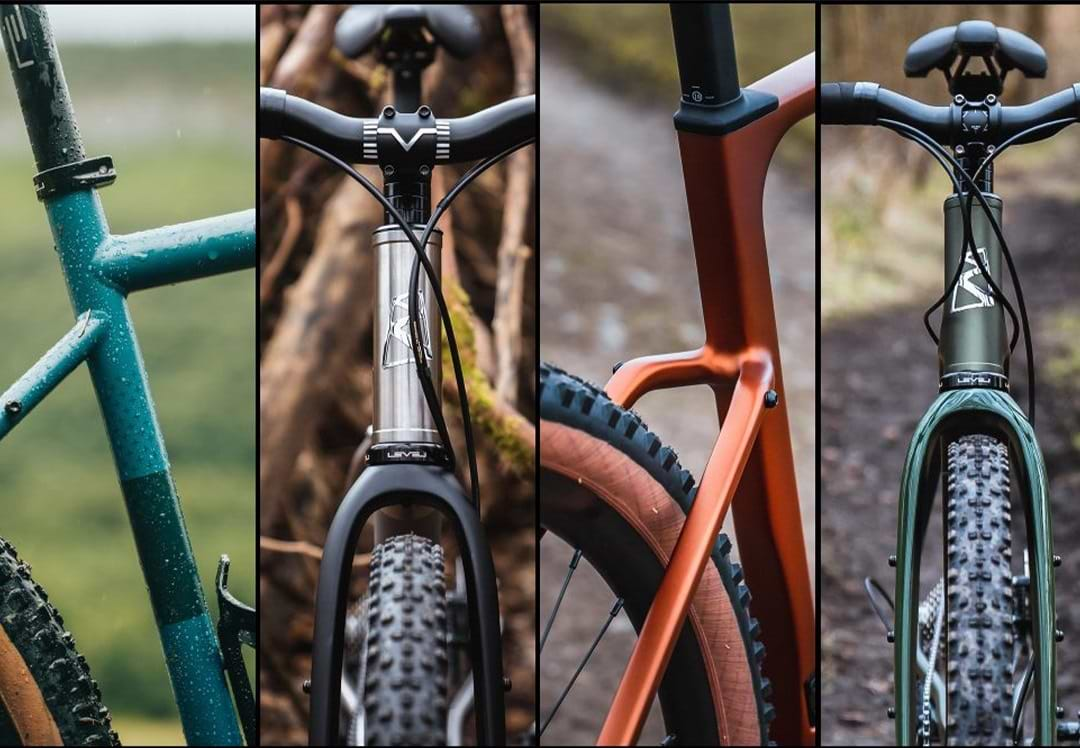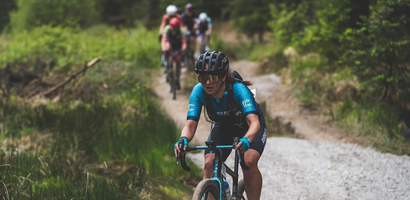
Gravel Bikes - Which frame material is right for you?
More riders than ever are swapping smooth tarmac for the freedom of gravel. The right bike will take you off the beaten track, link backroads with forest trails, and open up routes you’ve never explored before. That’s where a Ribble gravel bike comes in.
We build four gravel models in a range of frame materials, each with its own ride feel, performance benefits, and character. Whether you’re chasing speed, comfort, or all-day adventure, the material matters. Here’s what you need to know.
What exactly are gravel bikes?
It’s tempting to think of a gravel bike as just a road bike with bigger tyres, but that’s selling it short. Sure, you get the familiar drop-bar look, but with geometry inspired by modern mountain bikes for stability and control, plus tyre clearance that’s made for rough surfaces.
Gravel bikes are about versatility. They’re fast and efficient on tarmac, but just as happy on hardpack, towpaths, bridleways, and forest tracks. Unlike a mountain bike, they’re built for covering ground quickly, so you can link up multiple terrains without feeling like you’re dragging a sofa up the road.
Every Ribble gravel bike comes with mounting points for bottles, racks, and bags. Pack light for a fast day out, or load up for a multi-day bikepacking trip.
Aluminium
Pick aluminium if you want a tough, great-value frame that balances weight, stiffness, and durability. Modern alloy tech gives you a confident, comfortable ride without the harshness of old-school aluminium. It’s strong, dependable, and perfect for riders who want a capable all-rounder that can handle daily miles, weekend escapes, and everything in between.
ALLGRIT E AL
Light, capable, and built to go further. The ALLGRIT E AL delivers a natural-feeling electric gravel experience, so you can ride more, explore more, and push beyond what you thought possible.
- **Electric Confidence **- A stealth-integrated battery and motor provide up to 90km of range on a single charge – or over 150km with the optional range extender. With 45Nm of responsive torque and starting weights from just 13.9kg, it’s as capable as it is light.
- Adventure Versatility - With 50mm tyre clearance, full rack and fork mounts, and a choice of alloy or carbon riser bars, the ALLGRIT E AL adapts to your gear, your route, and your rhythm.
- **Comfort & Control **- Hydroformed aluminium tubing, a carbon fork, and balanced geometry combine for stable handling and a composed ride over rough terrain – keeping you confident, wherever the trail leads.
- Smart, Simple Integration - Discreet e-controls, internal cable routing, and seamless system integration keep things clean and intuitive. Over-the-air updates and optional extras make it ready for today and tomorrow.
ALLGRIT AL
From daily detours to cross-country escapes, ALLGRIT AL is your ticket to ride free. Confident, comfortable, and ready for the unexpected, it turns every trail into a path worth taking.
- All-Day Comfort - Hydroformed 7005 aluminium and a carbon fork combine with endurance geometry and 50mm tyre clearance for comfort that lasts all day. Built for big views, long rides, and zero shortcuts.
- Adventure-Ready Versatility - With rack, mudguard, fork, and bottle mounts, ALLGRIT AL carries what you need – and nothing you don’t. 1X or 2X compatibility and UDH integration keep it future-ready.
- Confident Handling - From fire roads to rough tracks, it stays planted. A T47 bottom bracket, integrated headset, and adaptable bar options give you direct control and dependable handling across any terrain.
- Durable Efficiency - Light, strong, and made for real-world riding. Aero-influenced shaping, internal cable routing, and a robust alloy frame deliver lasting value with performance you can count on.
Carbon
Choose carbon if you want the lightest, most efficient ride possible. It’s the go-to for riders chasing speed, elevation, and all-day performance. Compliance-tuned layups smooth out the rough stuff without losing stiffness when you put the power down. It’s fast, responsive, and ideal for gravel racing or long adventures where weight and efficiency matter most.
ULTRA-GRIT
Proven in the dust of Unbound, the chaos of The Traka, and the wilds of the Reiver – ULTRA-GRIT has real race pedigree. Built to go faster, further, and harder, it’s the gravel bike for riders with competitive grit.
- Aero Advantage - Headwinds don’t discriminate – and neither does ULTRA-GRIT. Aero tube profiles taken from our fastest road bikes, fully internal cable routing, and integrated cockpit options help you hold speed on any surface.
- Race-Tuned Handling - Control wins races. Race-optimised geometry, flex stays, and an asymmetric seat tube keep the frame composed under pressure. Multiple cockpit options let you fine-tune handling for fast corners and rough descents.
- Light & Efficient - Every watt matters. The 30T/33T carbon layup with M46 fibres keeps weight low and efficiency high. A threaded BSA bottom bracket adds stiffness and easy servicing without sacrificing performance.
- Endurance Integration - For solo missions or gravel epics, ULTRA-GRIT is adventure-ready. With 50mm tyre clearance, internal down tube storage, smart mounting points, and UDH compatibility, it adapts to your ambition without the fuss.
ALLGRIT E CARBON-X
For riders who don’t race the clock, the ALLGRIT TI-X is timeless adventure made real. Strong, composed, and calm, it’s built for the long way round – again and again.
- Contemporary but Timeless - Crafted from 3Al–2.5V titanium with precision 3D-printed joints, the ALLGRIT TI-X delivers a refined, vibration-dampened ride. It’s modern construction paired with a classic material – built to perform for a lifetime.
- Built to Endure - Naturally corrosion-resistant and ready for years of hard use. Internal cable routing, a T47 bottom bracket, and SRAM UDH compatibility make it as reliable as it is beautiful – mile after mile.
- Refined Versatility - Premium detail meets practical design. Racks, guards, and luggage all fit seamlessly. Compatible with 1X or 2X drivetrains and up to 50mm tyres, without compromising the clean, elegant lines.
- Composed Handling - Loaded or light, it stays calm and precise. Adventure-tuned geometry and cockpit flexibility keep it stable on long days and agile when the terrain turns technical.
Titanium
Go titanium if you want the bike that could outlast you. Naturally corrosion-resistant and famously smooth to ride, it’s the choice for big-mile adventurers who want a frame that shrugs off years of hard use. Titanium has a timeless feel – calm, composed, and built for the long way round, again and again.
ALLGRIT TI-X
Light, fast, and beautifully integrated – the ALLGRIT E CARBON-X is our most advanced e-gravel bike. Built to take you further, climb higher, and ride longer with power that feels natural.
- Naturally Powerful - A stealth-integrated battery and motor deliver up to 140km on a single charge – or over 200km with the optional range extender. With 55Nm of responsive torque and weights from just 12.2kg, this is a seriously capable, lightweight e-gravel machine.
- Adventure-Tuned Geometry - Compliance-tuned carbon, aerodynamic shaping, and a D-shaped seatpost balance speed and comfort. With 50mm tyre clearance, it stays smooth, fast, and ready for serious elevation.
- Seamless Integration - Hidden motor and battery, discreet e-controls, and internal cable routing keep the frame sleek and the ride refreshingly simple.
- **Carbon-Built Performance **- From all-day epics to post-work blasts, the ALLGRIT E CARBON-X delivers. A lightweight carbon chassis, wide tyre support, and intelligent power delivery make it the perfect partner for modern gravel adventures.
Steel
Choose steel if you value classic ride feel, toughness, and all-day comfort. Modern steel frames – especially high-quality tubing like Reynolds – combine natural vibration damping with the strength to handle heavy loads and rough terrain. It’s the material for riders who want a smooth, stable ride and a frame that’s easy to repair and ready for decades of adventures.
Gravel 725
The latest addition to Ribble's gravel lineup is the Gravel 725. It melds the traditional ride comfort of steel with contemporary design features to deliver a bike with classic aesthetics but distinctly modern performance characteristics. The frame is hand-assembled from high-quality Reynolds 725 steel tubing.
Reynolds is one of the world's oldest and most respected tube manufacturers in the cycling world. And has been producing high-quality steel tubing in its Birmingham factory since 1897. The material itself is very supple, which provides it with the natural vibration-absorbing property that is so cherished among the cycling fraternity.
The Reynolds 725 tubing that we use is heat-treated and tig-welded to form an immensely robust frameset capable of handling the rigours of multi-terrain riding.
- Strength: Steel is incredibly strong and isn't prone to fatigue while being highly resistant to dents in the event of a crash or accidental damage.
- Weight: While not as light as its carbon, alloy or titanium sibling, the Gravel 725's ride quality lets you sit in the saddle and just roll over the terrain with little fuss, maximum comfort and total satisfaction.
- Durability: Another area where steel wins out is durability. The high-quality Reynolds 725 steel tubing used to create the Gravel 725 can last a lifetime. As long as its care and maintenance are adequate, of course.
- Comfort: Similarly to titanium, steel is very supple, which lends itself to long-haul comfort. Its forgiving nature helps absorb the lumps and bumps, reducing rider fatigue through vibration reduction.

In summary
Which frame material you choose is based entirely on what you require from the bike. If you are looking for the fastest, lightest and most agile of gravel bikes to bullet along trails are heart-pumping speeds, the Gravel SL, Gravel AL, or Gravel AL e are the premium choices.
Those seeking long-haul comfort should seek out the vibration-damping capabilities of the Gravel Ti or Gravel 725. They may not be as fast or as agile as their carbon/alloy siblings. But if your idea of fun is sitting in the saddle, rolling along and taking in the wonder of nature, these make perfect sense.
How does the choice of material affect the ride? Who better to provide the answers to these questions than the folks at Global Cycle Network (GCN). GCN's test ride to find out more.
How do you qualify for the Gravel World Championships after only one gravel race? Check out Ribble Showroom assistant Metheven's incredible story to find out more.
Need help deciding which gravel bike suits you best? Discover the Ribble gravel range in our guide.










